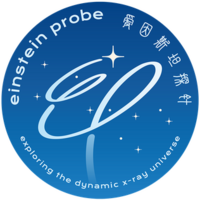


Einstein Probe artist impression
| |
| Names | Aiyinsitan Tanzhen |
|---|---|
| Mission type | Space observatory |
| Operator | CAS, ESA |
| COSPAR ID | 2024-007A |
| SATCAT no. | 58753 |
| Website | ep |
| Mission duration | 3 years (planned) 5 months and 26 days (ongoing) |
| Spacecraft properties | |
| Spacecraft | Einstein Probe |
| Bus | Phoenix-Eye-2 |
| Manufacturer | CAS |
| Launch mass | 1,450 kg (3,200 lb)[1] |
| Dimensions | 3 × 3.4 m (9.8 × 11.2 ft) |
| Start of mission | |
| Launch date | 9 January 2024, 07:02 UTC[2] |
| Rocket | Long March 2C[2] |
| Launch site | Xichang LC-3 |
| Contractor | CASC |
| Orbital parameters | |
| Reference system | Geocentric orbit |
| Regime | Low Earth orbit |
| Perigee altitude | 581 km |
| Apogee altitude | 596 km |
| Inclination | 29° |
| Period | 96 minutes |
| Instruments | |
| Wide-field X-ray Telescope (WXT) Follow-up X-ray Telescope (FXT) | |
 Einstein Probe Logo | |
The Einstein Probe (EP) is an X-ray space telescope mission by Chinese Academy of Sciences (CAS) in partnership with European Space Agency (ESA) and the Max Planck Institute for Extraterrestrial Physics (MPE) dedicated to time-domain high-energy astrophysics.[3][4] The primary goals are "to discover high-energy transients and monitor variable objects".[5] The telescope was launched by a Long March 2C rocket from the Xichang Satellite Launch Centre in China, on 9 January 2024, at 07:03 UTC.[6]
The primary science objectives are:[7]
Einstein Probe carries 2 scientific instruments: the Wide-field X-ray Telescope (WXT), and the Follow-up X-ray Telescope (FXT).[8] Both telescopes utilize X-ray focusing optics.
The probe weights 1450 kg and is 3-by-3.4 metres.[4]
Einstein Probe was launched on 9 January 2024, at 07:03 UTC by a Long March 2C rocket from the Xichang Satellite Launch Centre in China, and successfully placed in low Earth orbit at an altitude of 600 km[2] and an inclination of 29 degrees, giving an orbital period of 96 minutes.[11]
CAS reported that EP "performs as expected in the first month".[12] The probe detected fast X-ray transient EP240315a,[13] and bright X-ray flares EP240305a[14] and EPW20240219aa.[15]
|
| |||||||||||||
|---|---|---|---|---|---|---|---|---|---|---|---|---|---|
| Operating |
| ||||||||||||
| Planned |
| ||||||||||||
| Proposed |
| ||||||||||||
| Retired |
| ||||||||||||
| Hibernating (Mission completed) |
| ||||||||||||
| Lost/Failed |
| ||||||||||||
| Cancelled |
| ||||||||||||
| Related |
| ||||||||||||
| |||||||||||||
|
| |
|---|---|
| Earth observation |
|
| Communication and engineering |
|
| Data relay satellite system |
|
| Satellite navigation system |
|
| Astronomical observation |
|
| Lunar exploration |
|
| Planetary exploration |
|
| Microsatellites |
|
Future spacecraft in italics. | |